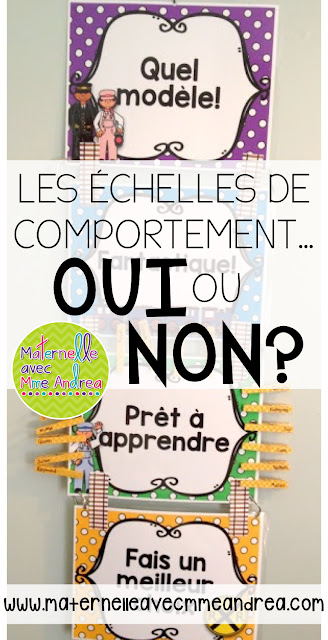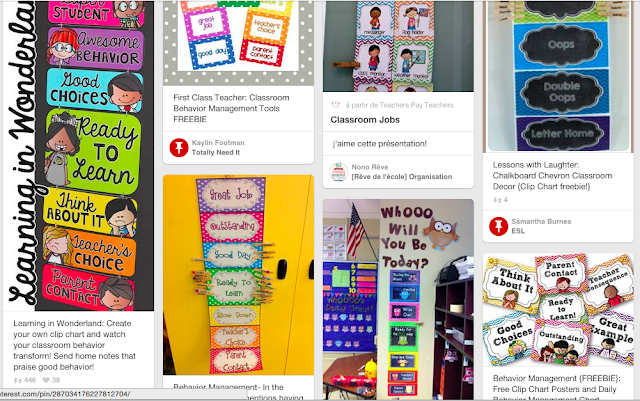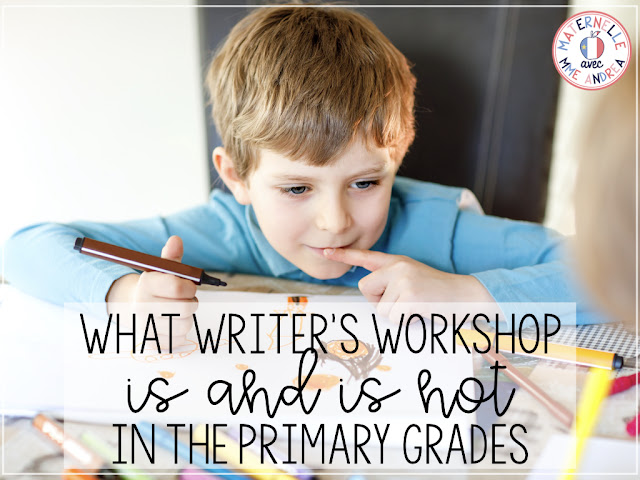Grab your coffee – this is a long one! :)
Clip charts – yay or nay? Ask your teacher friends what they think about behaviour clip charts, and you will probably hear a LOT of differing opinions! Many teachers have used them successfully (and not so successfully) in the past, but it seems that there is a new movement among teachers to “ditch the clip charts” and use other classroom management techniques, for a variety of reasons. Today, I am going to share my thoughts on clip charts, and whether or not I think they can be an effective, positive way to promote positive behaviour in the classroom.
A quick Pinterest search for Clip Charts shows that there are MANY different kinds of clip charts being used in classrooms, with various colours, statements, and themes. Here are a *few* examples of what kinds are out there, taken from a screen grab on my Mac :
Basically, a clip chart consists of rainbow-coloured cards organized in a specific order, as determined by the teacher. Generally, green seems to be the base colour that every student starts on when they arrive at school (Ready to learn). From there, based on each students’ individual choices, they can clip up to a higher colour, or clip down to a lower colour. Clip charts can provide students with visual reminders to change their choices, as well as encouragement and motivation to make good choices. Sounds rosy, right?
So why are so many teachers suddenly urging others to “ditch the clips”?
There are a few reasons why clip charts may not be the best choice for behaviour management. First of all, they are very PUBLIC. If one student makes a mistake, everybody knows it. Imagine for a second that your principal had a clip chart for teachers in the main office, and every time you made a mistake or temporarily forgot what a good choice was, your clip got moved down for the world to see. Now imagine that you are only learning what a good choice even is – it may not mean the same thing at school as it does at home or in the community, depending on your principal’s expectations and your reality outside of school. Embarrassing, right?! Everyone makes mistakes sometimes.
Secondly, students definitely notice where their friends are landing on the chart. And they report it. And they can kind of develop prejudices about it. I have had parents tell me in the past that their child came home and told them who was on yellow and red every. single. day. I have had students say to me when I moved a clip: “don’t worry, that’s normal. Last year, she was on the red ALL THE TIME!”. My heart broke that day.
Also, getting their clip moved REALLY STRESSES SOME KIDS OUT. Understandably! I have had students enter into complete meltdowns when their clips were moved. Think about it – kids are impulsive. It’s in their nature. Most times, they aren’t premeditating all the things they can do to get their clip moved down. So when they slip up and know that their clip will be moved, it is stressful for them! Should a mistake really be used to punish them all day by having them (and their peers) see a constant reminder of their slip up? And possibly be punished again at home when their parents find out “what colour day” they had? Clip charts don’t necessarily work for all students, and can cause more headaches (ie. meltdowns) than they are worth.
So then, why use one??
Do I think that they can be used effectively? Absolutely. Do I use one? Yes. Do I think that they work for every single student and should be the only system in place in a classroom? No. Do I think that everyone uses them effectively and that just by using one, teachers are doing the right thing? Not necessarily. Look, I honestly believe that teachers have the best intentions. In no way am I trying to imply that by using a clip chart, teachers want to punish children. But we are tired, and busy, and overwhelmed, and sometimes it is just easier to move a train and have a principal or a parent deal with it. Sometimes, teachers don’t know HOW to use a clip chart to teach instead of to punish. But if you want to use a clip chart effectively and positively (for EVERYONE), that’s what you have to try to do – teach and give opportunities for learning instead of punish.
I have already told you that I use one in my classroom. I will be honest and say that it wasn’t my choice – I arrived at my school and was told (kindly), “this is the system we have in place to manage behaviour school-wide. Use it!”. So, I use it, and I have used it for the past 3 years. My first year – NOT a success. My second year – quite a bit better. And last year was honestly awesome, and I think I have figured out a way to use a clip chart successfully and effectively. Not to control my students’ behaviour… but to teach them to make appropriate, positive choices, with lots of room for error and slip ups on their part, that they can then use to learn and grow. I think that is an important distinction to make if you decide to use a clip chart in your classroom.
My first year, I did exactly what I was told to do. Three train tracks (green for good, yellow for a first offence, red for a second, and if there was a third, straight to the office). Each student had decorated a train that sat on the green track each morning and moved down if students misbehaved. And there were a LOT of tears, a LOT of meltdowns, and A LOT of trips to the office (I am so sorry to that class!). And some kids’ trains sat on green all year long and didn’t even move once. And I didn’t like what was happening in my classroom, but what could I do? I had to use it.
My second year, I discovered Pinterest and the idea of “clipping up”. I left the three tracks I had, and added a blue and a purple to the top. When kids went above and beyond, were extra kind, etc., they clipped up. There were MANY opportunities for them to clip up – I had a beyond phenomenal group of extremely kind and wonderful students. I loved the clipping up – it completely changed my focus and made me search out and notice positive behaviours instead of focussing on negative ones. There is nothing like clipping up the one child who is looking and listening when you are ready to start a lesson while everyone else is talking to motivate the whole group – without ever saying “Listen! Be quiet! 1, 2, 3 – Eyes on me!”. You don’t even have to say a word… just walk dramatically over to the chart and move that one clip. However, it still wasn’t perfect. I had a few kids who were still clipping down, and who were still very upset about it. I still had some kids going to the office. I still had some kids telling their parents that other kids were “bad” because their train got to red.
Last year, I started out the same as the year before. I had “looped” one of my kiddos who was occasionally on red and was teaching her for a second time (the very same child who I was told not to worry the first time she got there by another student, as she had ALWAYS been on red the year before). I had a new kiddo with a medical condition that affected his brain and his ability to self-monitor his behaviour and follow routine. It became very apparent very quickly that clipping down was NOT going to be something that would work for him. So, clipping down trains didn’t work for those two, and I honestly had no one else get to red even once for the first two months. I had changed my yellow track a bit – instead of having to stay on it and be punished all day long/unable to slip up again without going to red, I changed it so that their train only stayed on yellow while they were making a negative choice. The second that they fixed their behaviour, they hopped right back up to green. I reassured them that EVERYONE makes mistakes and that is no problem – it is only a problem if you don’t use your mistakes to learn and grow. I had also worked really hard on building our classroom climate, and had very few behaviour issues from the group as a whole. So… I got rid of the red. I felt like it was up on the bulletin board being very ominous, showing my students that I expected that they were going to make bad choices eventually. So I took it down to show them that I had confidence in them that if they DID make some inappropriate choices, that they would fix their behaviour and hop right back up to green. If someone forgot a rule, I would say something like, “oops! I see that during this round of centre time, you forgot to stay in one place and work for ALL of the minutes. I am going to just put your train on yellow and once you show me what you can do during the next round, you will hop right back up to green – no problem!” “Uh oh, I see that you are having trouble keeping your body to yourself and it is distracting your neighbour. I am going to just put your train on yellow and once you show me how you can keep your body to yourself, you will go right back up to green! No problem!” By me not being angry and really just using it as a reminder, my students didn’t get upset. They really do want to do their best. I had ZERO TEARS after I changed the way I spoke to them. I usually didn’t even make it to the chart to move their train before they fixed their behaviour. I decided to give them the benefit of the doubt 99% of the time – they weren’t behaving inappropriately on purpose, they just made a mistake. And we all make mistakes and that is no problem – we can fix them! For my sweeties who weren’t always able to change their behaviour, I put a different (private) system into place with the help of the resource teacher, and I only used their trains to clip up when they were being awesome. Of course, there were still some things that went beyond trains and it was clear to my students that if they crossed the well-defined line, there would be no warnings and they would have to go to the principal (things like punching or swearing, for example), but that happened extremely, extremely rarely – I am not sure that it even happened in the classroom at all last year.
So, long story short, I DO think that you can use a clip chart to teach your students to make good choices. Yes, good behaviour should be its own reward, but guess what? Our students are still learning what good behaviour IS, and clip charts can help them identify examples of what are appropriate and inappropriate choices. When they see someone clip up, they can say to themselves “ohh, THAT is how Mme wants me to talk to my friend. That is how I am supposed to stay on task. That is what is looks like to solve a problem on my own”. When they clip down, they can say to themselves things like, “whoops, I forgot to stay on task. Now I will get back to work and I can get my train right back up there. No problem!”
If you are interested in using clip chart trains in your classroom, I had a mishap with the custodian, my clip chart, and a dumpster last year and needed to make a new one for this year ;), and I put it in my TPT store. However, if you find yourself using a clip chart to try and CONTROL your students’ behaviour or to punish them, clip charts may not be for you. To avoid embarrassing and upsetting your students, in my opinion, make sure that you want to use your clip chart as a teaching tool, to show them what good choices look like, and how to self correct their behaviour and continue on with their day.
Here is what my new clip chart looks like!
I am using four colours this year, as I did at the end of last year. It’s pretty easy to assemble – just print, laminate, and attach using binder clips. I added little track images connecting them as well, to go with the train theme ;)
 |
| Ellie decided to help me assemble it! |
Making your students’ trains is easy, too!
I actually like to take my trains to the next level and provide my students with a little extra incentive/reward to get to purple and blue. It is super simple, and no dollar store prizes are involved ;). I make four clothespins for each student, with four different colours of washi tape(affiliate link). After they have been to blue or purple five times with their first train (I keep track by adding dots with a Sharpie to the inside of the clothespin each time they clip up), they trade their clothespin in for a green one. After five more times, they get a blue one, then a sparkly silver one (oooooooh, ahhhh!), and finally, after five more times (20 total since the beginning of the year), they get to have lunch with me from the cafeteria!! It is seriously the best prize ever and those lunch dates are the highlights of my year. I LOVE getting to spend that one-on-one time with those who earn it. They are hilarious and awesome and I love them so much!
 |
| Just look at that sparkle! I just tape their (laminated) paper train to the clothespin and then switch it out as needed. |
I have put everything I use to make my chart and instructions in my TPT store. The product is editable, so you don’t have to use the same colours or phrases as me! I included the four tracks that I use, and eight blank templates that you can edit to suit your needs. There are also blank trains for your students to colour, “brag bracelets” that I give to students when they clip up to show their parents (easier & faster for me than writing a note in their agenda), and a copy of the note that I fill out with my students who may not have made good choices and had to have a discussion with me, to be signed and returned by parents.
Just click on any of the pictures above, or RIGHT HERE to see it in my store!
Happy clipping! :)

















Envoie ce post à l'une des soeurs de Profs et Soeurs, elle cherchait un tableau comme cela en français il n'y a pas si longtemps. :)
Merci!! :)